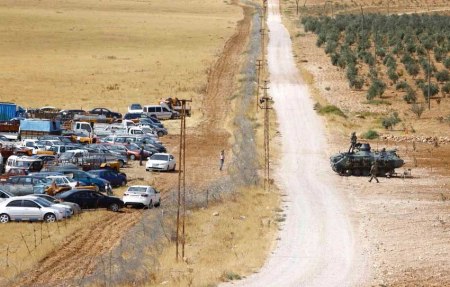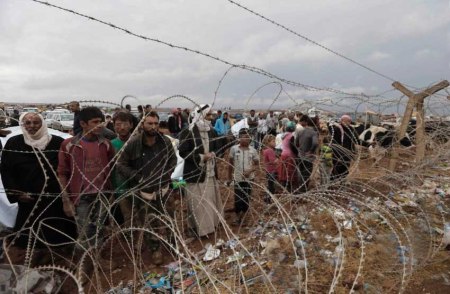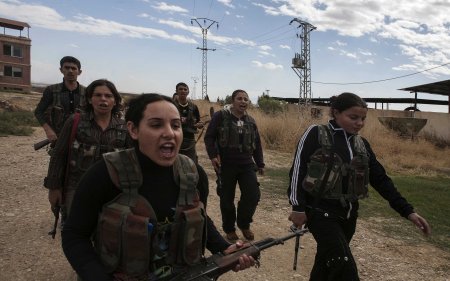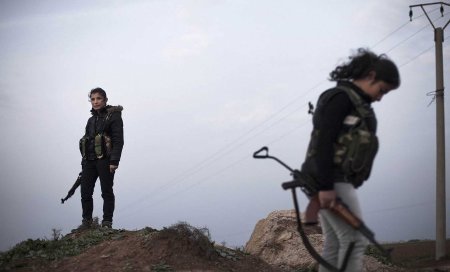Saada Oulouh As-Safir
Ismail, who hails from the village of Ali Shar in Aleppo’s countryside, looked through the binoculars and pointed to a house about 200 meters away. “That is my house and this is the tree that I planted before building my home,” the Syrian Kurd told us, after fleeing with his wife and children to the village of Alizar across the border in the Kurdish area of Turkey.
Near Ismail’s house, he could see through the same binoculars IS (Islamic State) militants milling around after having overrun the village on September 26. Dejectedly, Ismail looked on and said, “They are resting under my tree.”
Ali Shar is located in the eastern area of Ayn al-Arab, which the Kurds call Kobane, adjacent to the Turkish border. It fell after violent clashes between the YPG (Kurdish People’s Protection Units) and IS, to become one of the 120 villages and towns controlled by IS in the Ayn al-Arab land strip that adjoins Efrin and Hassaka province. The fall of these villages was confirmed by YPG spokesman Redor Khalil.
Ayn al-Arab includes around 380 villages and towns, smaller in size than the villages and towns of Hasakah, and with a total land area of 3,850 square kilometers. They are all threatened by IS forces concentrated between Efrin and Ayn al-Arab on one end, and Ayn al-Arab and Hasakah on the other.
The Turkish-Syrian border has dramatically changed in the last 16 days, as IS attacked this part of Aleppo and Hasakah’s countryside, isolating parts of it after gaining control of the areas once occupied by the FSA (Free Syrian Army) and Jabhat al-Nusra.
YPG spokesman Khalil also indicated that violent clashes took place on September 30 in the vicinity of Kobane, particularly on the southern front toward Sarrin, adjacent to the Qarqozat bridge that links Hasakah with Aleppo province.
As the clashes intensified, the Turkish-Syrian border area seemed beyond the control of Turkey, as the latter sought to receive parliamentary approval allowing it to “conduct military operations in Iraq and Syria against all potential threats and dangers,” Turkish Deputy Prime Minister Bulent Arinc said.
YPG spokesman Khalil thought it unlikely that Turkey would receive said approval and that, at the very least, “the world would stand against such an eventuality because it constituted an occupation of Syria.” Furthermore, Khalil said, the border itself changed dramatically as a result of Turkish restrictions imposed on the movement of people displaced from Ayn al-Arab and the surrounding areas, leading to tens of thousands remaining stranded at the border, after having successfully fled the IS hell.
Despite this, Kurdish regions in Turkey were teeming with thousands of Syrian and Kurdish refugees who entered Turkey illegally from Syria or through the Iraqi border. As a result, the whole border area was boiling over with male and female Kurdish volunteers who came to join the ranks of the YPG. Their memories were still fresh with stories of Kurds and Yazidis being massacred and persecuted, to the point where their women were raped or sold into slavery, while ethnic cleansing was perpetrated against the men in many villages. Similar stories were told by escapees who fled to camps erected in the cities of Diyarbakir, Mardin, and others.
Confronted with such threats, the Kurds, according to Ismail, rose up in Syria “as one; for the issue is an existential one of life and death, and we will not allow the fall of Rojava.”
Rojava, as the Kurds call the Syrian area in which they form a majority, means “western Kurdistan.” From east to west, it includes Maabada, Jawadiyah, Qahtaniyah, Ras al-Ayn, Tell Abyad, Ayn al-Arab and Efrin. This is the region where IS managed to isolate some areas and occupy many villages.
Ismail added that the villages overrun by IS splitted Efrin from Ayn al-Arab, while the takeover of some others led to the isolation of Hasakah’s villages from Ayn al-Arab, which is now under attack on three fronts. Meanwhile, IS seeks to occupy one of the strategic mountains in the region, which would give the jihadis effective control of the surrounding areas.
Three days ago, Ismail stood with many other Kurds on both sides of the Syrian-Turkish border (in Turkish Alizar, which is separated from Ali Shar by a Turkish army border control point) to clap and cheer a warplane circling above, which Ismail said was “less than 500 meters away.” The men thought that the aircraft belonged to the US-Arab alliance that had declared war on IS, and which, they hoped, would contribute in weakening their enemy. But, minutes later, the cheering turned into angry cries and condemnation, as the people saw the plane “bombing a group of YPG fighters while staying clear of IS forces.”
YPG spokesman Khalil didn’t confirm to As-Safir that YPG fighters were bombed by warplanes.
In contrast, Ismail affirmed that he and some other men saw the plane, the identity of which they could not determine. “Maybe it was a Turkish, US-Arab coalition, or Syrian plane”; although he added that no Syrian airplane flew in the area since regime forces withdrew from there.
Some postulate that the aircraft was Turkish; an opinion reinforced by the Turkish position toward their popular resistance force, which “they will not allow to cross the border and fight IS.” In addition, the Turks not only prevent Kurdish fighters and supplies from crossing the border to Ayn al-Arab and its surroundings but also target many of them, leading to casualties, as confirmed to As-Safir by a commander of the female corps in the Sourouj area.
The commander was a young woman in her 30s, who refused to be identified for security reasons. She had just returned from Kobane and insisted, that they will “never allow the town to fall in IS’ hands ….The fate of the Kurds there will not be similar to that of the Yazidis,” she firmly said amid a great gathering of women in the town of Sourouj.
Sourouj, the largest Kurdish town in Turkey adjacent to the Syrian border, is teeming with thousands of Kurdish men and women who came from various Kurdish areas in Turkey and Iraq to join the ranks of the YPG as volunteer fighters, or from Syria to seek refuge.
The reports about IS’ crimes had their effect on the inhabitants of Ayn al-Arab, where the men made sure that all women and children vacated the villages besieged by IS. Sourouj’s mayor, Zouhal Ikmaz, told As-Safir that the town was hosting approximately 70,000 refugees from adjoining Syrian areas. This is clearly evident in its streets filled with the young and old alike. Some of them sleep in the middle of roads or on street corners, because schools, public institutions, mosques, and event halls are unable to accommodate more. Sourouj’s private homes welcomed thousands of refugees, at a time when the Turkish government refrained from helping them, leaving the burden of that responsibility to the Kurdish community.
The Kurds from Diyarbakir to Mardin, Sourouj, and the areas along the Turkish-Syrian border sounded the “general call to arms.” In this regard, the already mentioned female commander said that even leftist Turks came to volunteer in Sourouj and entered Ayn al-Arab to train alongside Kurdish men and women. There are also volunteers from various other countries. “The battle is international and no longer an insignificant side note,” she said.
There are no training camps in Sourouj or any other Turkish territories, because the Turkish army prevents Kurdish fighters from setting up camps and crossing the border.
Making the sign of victory with other women around her, the female Kurdish commender said, “We do not recognize all these regimes and their interests. We will not allow our areas to fall, and will pay any price to prevent that from happening. We shall prevail.”
Despite the great hardship and suffering that the recent developments have caused, it seems clear that the Kurds view the events from the point of trying to achieve their ultimate goal of building a Kurdish homeland. Kurds from Syria have established a new legal system upon which they have agreed to rule their lands and govern their lives. It includes among other principles total equality between men and women.
It is an equality currently being translated by Kurdish women on the battleground, “where their numbers account for half the number of all Kurdish fighting troops,” according to Ismail, who was himself getting ready to return to Ayn al-Arab. He added, “Lightly armed YPG forces were confronting IS fighters bearing the most sophisticated of weaponry received from the major powers that backed and equipped them from the very start.”
Ismail also confirmed the predominance of US weapons in the hands of IS, “from tanks to cannons and heavy weapons, some of which may be weapons captured from the Iraqi army.” Despite the great disparity in capabilities, the inhabitants of Ayn al-Arab and all Kurds of the region have taken a solemn decision “not to let our areas fall under the control of IS, which we will resist.” Accordingly, the female commander affirmed that only mothers, children, and senior citizens were fleeing besieged areas. “Every woman and man between 15 and 60 years of age has a duty to fight,” with the exception of the sick and of mothers who have children to tend to. “We do not want any mother to leave her children, for raising them is, in itself, an act of resistance.” The role of mothers in Sourouj and Alizar is not confined to raising children though, as “they also help refugees, secure their needs and collect all kinds of donations from the Kurdish community.” In addition, many of them have sold their jewelry, while families have opened up their homes and businesses to shelter the thousands of refugees fleeing the horrors of war.




Keine Kommentare:
Kommentar veröffentlichen